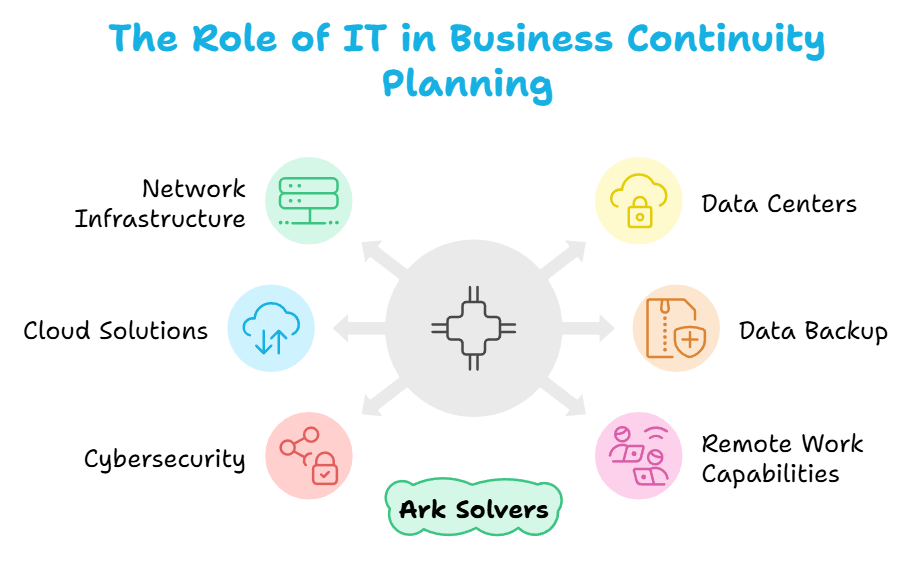What is The Role of IT in Business Continuity Planning?
In today’s fast-paced world, keeping businesses running is key. It helps a lot in this area. It ensures companies can keep going even when things go wrong.
Natural disasters or cyber attacks can stop a business. But with IT, they can keep their systems and data safe, which is very important for staying strong.
So, what does IT do in business planning? How does it help prepare for and deal with emergencies? This article will explore these questions. You will learn how IT helps businesses stay strong through tough times.
Key Takeaways
- IT is crucial to modern business continuity planning, ensuring organizations can maintain operations during disruptions.
- Reliable network infrastructure, secure data centers, and cloud-based solutions are essential for building IT resilience.
- Effective data backup and recovery strategies and robust cybersecurity measures are vital for safeguarding critical information.
- Remote work capabilities and secure system access enable organizations to adapt and continue functioning during unexpected events.
- Comprehensive risk assessment and management of IT systems are necessary to identify and mitigate potential threats to business continuity.

Understanding Business Continuity Planning and IT Integration
In today’s fast-paced world, IT is key for businesses. They use digital tech to run their operations, and IT helps keep businesses going even when things go wrong.
Core Components of BCP
BCP has main parts, such as risk checks and disaster plans. IT helps a lot with these. They use their skills in data and security to make businesses strong.
Read More: What is Business Continuity? A Complete Guide
IT’s Strategic Position in Modern Business Operations
IT is now a big part of keeping businesses safe. They use cloud tech and data to help. IT experts help find risks and make plans to keep businesses running.
Evolution of IT in Business Continuity
IT’s role has changed a lot. It used to help, but now it leads. IT makes sure businesses can keep going even when things get tough.
What is the Role of IT in Business Continuity Planning?
In today’s world, IT is key for keeping businesses running smoothly. IT disaster recovery, cybersecurity, and data protection are vital. They help keep a business going even when things go wrong.
IT is very important in planning for business continuity. It ensures that IT systems are part of the plan, which helps businesses deal with unexpected problems like natural disasters or cyber-attacks.
Let’s look at how IT helps businesses stay strong:
- Data Backup and Recovery: IT ensures that important data is safe and can be quickly found again. This is crucial for keeping the business running when data is lost.
- Incident Response and Cybersecurity: IT helps fight cyber threats. It ensures strong security and can handle emergencies, keeping data safe and the business running.
- Remote Work Enablement: IT helps workers stay productive from anywhere. This is especially important during times like the COVID-19 pandemic. It keeps business going even when offices are closed.
By making IT a big part of business planning, companies can be more resilient, reduce downtime, and keep important data safe. IT is very important for a strong business plan.
Critical IT Infrastructure Components for Business Resilience
A strong IT setup is key to keeping your business running smoothly today. This includes network systems and data storage. Each part is key to ensuring your business can keep going even when things get tough.
Read More: What Is IT Infrastructure Consulting?
Network Infrastructure and Connectivity
A good network is the heart of your IT. It keeps communication and data flowing. Having backup plans, like extra internet and network devices, helps keep things running when problems arise.
Data Centers and Storage Solutions
Protecting your data is very important. You need a plan for backing up and recovering your data. Using cloud services and different data centers helps keep your data safe, no matter what happens locally.
Cloud Computing Integration
Cloud computing has changed how we handle IT. It offers scalability, reliability, and access from anywhere. Adding cloud apps and storage to your plan can make your business more resilient.
Focusing on these key IT areas can make your business more resilient. A solid plan for IT redundancy helps you face challenges head-on. It keeps your business running smoothly, no matter what.
Data Backup and Recovery Strategies
Keeping your business data safe is very important today. As an IT expert, I know how key good backup and recovery plans are. They help keep your business running smoothly.
Good backup plans are the base of disaster recovery. They protect your important data from many dangers. You can choose from cloud or on-site storage for backups.
But backup is just the start. You also need a solid recovery plan. This plan should help your business get back to normal fast. Testing and updating your plan keeps your business strong.
Every business is different, so there’s no single best plan. Work with your IT team to make a plan that fits your business. This will protect your data well.
Protecting data is not just about tech. It’s also about being ready as a team. Teach your team about data safety and check your plans often. This keeps your business safe from trouble.
Backup Methods to Consider
- Cloud-based backup solutions
- On-premise storage and backup systems
- Hybrid backup strategies
- Automated backup scheduling and monitoring
- Offsite data replication and redundancy
Best Practices for Disaster Recovery
- Establish clear recovery time and point objectives (RTOs and RPOs)
- Regularly test and validate your recovery strategies
- Implement secure and redundant data storage solutions
- Develop comprehensive incident response and communication plans
- Train and educate your employees on data protection protocols
Make data backup and recovery a big part of your business plan. This keeps your data safe. Start preparing for disasters before they happen. With the right plans, your business can come back stronger.
Cybersecurity Measures in Business Continuity
In today’s world, keeping your business safe online is key. Good cybersecurity protects your data and helps your business stay strong when things go wrong.
Threat Detection and Prevention
It is very important to stay ahead of cyber threats. Use strong security tools like firewalls and antivirus to watch for dangers. Also, check your systems often to find and fix weak spots.
Security Protocol Implementation
Setting up strong security rules is a must. To keep information safe, use encryption and secure ways to share data. Also, teach your team about staying safe online.
Incident Response Planning
Even with excellent security, bad things can still happen. Having a plan for these times is crucial. It should tell you how to quickly find, fix, and learn from problems.
Adding strong cybersecurity to your plans strengthens your business. Always be ready and watchful to keep your business safe and running smoothly.
Remote Work Capabilities and System Access
In today’s world, keeping work going smoothly is key. IT helps a lot with this by making remote work easy and safe. They use new tech to help businesses stay strong, even when things get tough.
Having good remote access is very important. With tools like VPNs and cloud apps, workers can access important information from anywhere. This keeps work going and improves work life.
Good communication is also key. Tools like video calls and messaging help teams work together, and training helps everyone use these tools well.
With the right tech and training, teams can handle any problem. This keeps work going and helps businesses grow. It’s all about being ready for anything.
Risk Assessment and Management in IT Systems
In today’s fast-changing world, keeping IT systems safe is key. IT systems are the heart of modern business, and they need careful monitoring to avoid threats and weaknesses.
By spotting and fixing these issues, companies can become stronger and continue running smoothly even when things go wrong.
Identifying Potential IT Risks
The first step is to check for risks in IT systems. Look at the tech setup, such as networks and data centers. Find weak spots and fix them.
Impact Analysis and Mitigation Strategies
After finding risks, do a deep dive to see how they could hurt the business. This helps plan how to fix problems. Use system redundancy planning, data backup and recovery procedures, and strong cybersecurity measures.
Regular System Audits
Keeping IT systems safe is a never-ending job. Regular checks are key to keeping things running smoothly. These audits spot new threats and check if current plans work.
By tackling IT risks head-on, companies can make their systems more reliable. This helps them stay strong, even when faced with significant challenges.
How Ark Solvers Enhances Business Continuity Through IT
At Ark Solvers, we know IT is key to smooth business flow. We help make businesses strong and quick to adapt. Our top-notch IT solutions make us a go-to partner for many.
Our Comprehensive IT Solutions
Our experts work with clients to build strong IT systems that can handle tough times. We offer everything from secure networks to advanced cybersecurity.
Success Stories and Case Studies
Our hard work has paid off in many success stories. Clients have moved to remote work, kept their data safe, and stayed ahead in their markets. Working with Ark Solvers has made a big difference for them.
Also Read,
- How Much Does a Business Continuity Plan Cost?
- Key Benefits of Business Continuity Planning
- What are the 5 Steps of a Business Continuity Plan?
- What are the 6 Pillars of Business Continuity?
FAQ
What is the role of IT in business continuity planning?
IT helps keep businesses running smoothly, ensuring they can get back to normal after problems. It does this by having plans for disasters and keeping data safe.
What are the core components of a business continuity plan (BCP)?
A BCP has a few main parts. It includes examining how problems affect the business, developing plans for recovering data and keeping it safe. It also includes ways to work from home and checks for risks.
How has the role of IT in business continuity planning evolved?
IT’s role has changed a lot. Now, it’s more important than ever. It helps with cloud computing, keeping data safe, and working from home.
What are the critical IT infrastructure components for business resilience?
Important IT parts include strong networks and data centers. They also need cloud computing to stay safe.
How do data backup and recovery strategies support business continuity?
Backing up data is key. It helps restore normalcy after problems. It’s about having plans and ensuring data safety.
What is the role of cybersecurity in business continuity planning?
Cybersecurity is very important. It keeps threats away and has plans for when attacks happen, helping keep businesses safe.
How do remote work capabilities support business continuity?
Working from home is very helpful. It allows people to continue working even when they can’t go to the office, and IT makes it possible.
What is the process for assessing and managing IT-related risks in business continuity planning?
First, determine what risks exist. Then, assess how they might affect the business. Next, make plans to address them. Regular checks are also important to keep IT systems safe.






